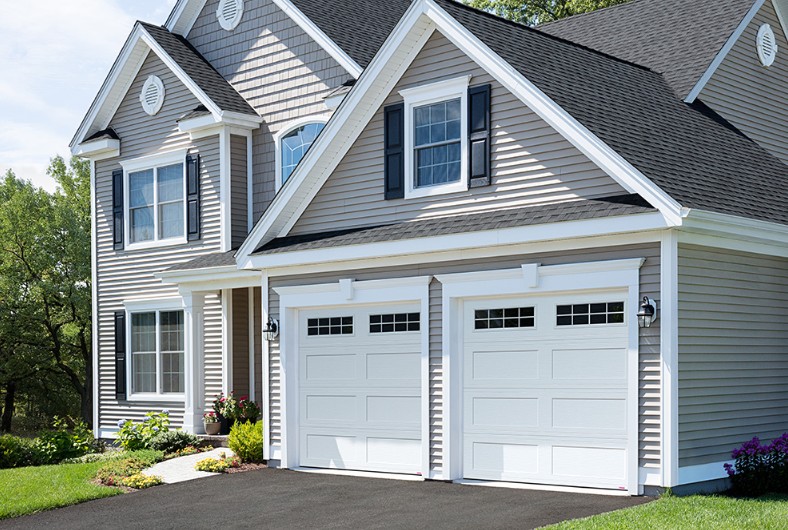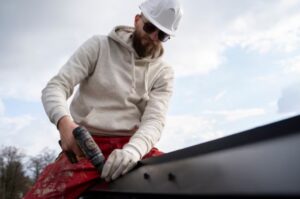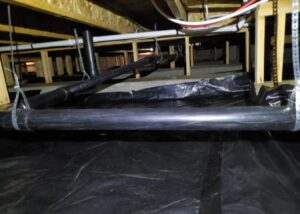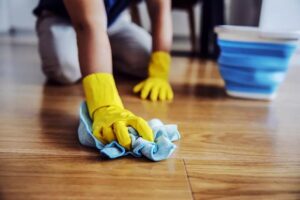The 4 Best Robot Vacuums for Keeping Your Floors Clean

Robot vacuums have come a long way since they were introduced in the early 2000s. Today, robot vacuums are equipped with a range of sensors and smart features that make them surprisingly powerful cleaning machines that autonomously take care of your home. There are hundreds of robot vacuums available now, ranging anywhere from $50 to $1,000 or more in price. “I advise anyone who is looking to purchase a robot vacuum to do their research beforehand and identify the most important features so they don’t waste money on other add-ons they may not truly utilize or need,” says Leanne Stapf, chief operating officer of housecleaning franchise The Cleaning Authority.
We spoke to cleaning experts to narrow down the best brands and models you can buy today, and we tested eight popular vacuums to find which perform the best in terms of cleaning, obstacle avoidance and smart features.
The best robot vacuum we tested, hands down, was the iRobot Roomba s9+. It aced every challenge we threw at it, picking up a range of debris, and it was a pleasure to use thanks to its user-friendly app and next-gen smart mapping. The Eufy RoboVac 11S is the best lower-price pick, offering surprisingly thorough cleaning abilities with a price tag that’s often under $200. We found the Roomba j7+ and Shark AI Ultra Robot Vacuum to be great options as well.
If you’d like to read how we vetted and tested robot vacuums and which experts we consulted, scroll down for more detail.
Best overall robot vacuum
Buy Side Top Pick
Pros
- Powerful suction
- Effective on all types of debris
- Dirt-detection technology
- Self-emptying
- Superior app experience and mapping abilities
- Effective D-shaped design
Cons
- Taller height doesn’t fit under some furniture
- Higher-price
Specs
- Dustbin capacity: 1 liter
- Runtime: 120 minutes
- Robot height: 3.3 inches
When it comes down to sheer cleaning performance and ease of use, the iRobot Roomba s9+ is the obvious choice for your home. It delivered the most thorough clean of all the robot vacuums we tested, effectively picking up large debris, dirt and fine dust particles from a variety of flooring surfaces. It’s also the best robot vacuum for pet hair.
While other vacuums often scattered pieces of dried rice around the hard floor as they cleaned, the s9+’s powerful suction and larger-than-average brush roll captured more debris on every pass, leaving our floors practically spotless by the time it finished cleaning. Its dual rubber brush rolls proved to be just as effective on carpeting, picking up the vast majority of pet hair from a medium-pile area rug without getting the long strands tangled up in its brushes—an area where cheaper vacuums struggled. We were also impressed by the model’s dirt-detection abilities: Whenever it approached an area where we had sprinkled dirt or other debris, the vacuum would automatically slow down its pace, going slowly over the trouble area to maximize its pickup. The technology was truly impressive to watch, and it was effective, too, outperforming other Roomba models as well as the other brands we tested. And when the onboard dustbin filled up, the robot simply navigated back to its self-emptying base to unload the debris, then resumed cleaning without any intervention.
Of all the brands we tested, iRobot has the most user-friendly and intuitive app design. We were able to sync the s9+ with its app on the first try, and all its main features are laid out on one screen, making it easy to find the vacuum’s key settings. The s9+ also created one of the most accurate maps of our testing area. The robot was able to create the detailed map after two cleaning runs, including automatically marking carpeted areas. From there, we were prompted to label individual rooms, create “no-go” areas (such as where there are power cords or other obstacles like pet bowls) and even select special cleaning zones that might require more frequent vacuuming. The process of editing the map within the iRobot app was easy and intuitive—the Shark app offers similar features, but it’s a bit clunkier to use.
When compared with other models, including those from iRobot, the Roomba s9+ stands out thanks to its unique D-shaped design. Because of its unconventional shape, the robot has a 30{3ad958c56c0e590d654b93674c26d25962f6afed4cc4b42be9279a39dd5a6531} larger brush roll than round Roombas, and it’s also able to navigate closer along the edges of the room and into corners. True to the brand’s claims, the s9+ outperformed the competition in these areas—it removed virtually all traces of the dirt and dust that we scattered along the edge of the testing area and in a tight corner. We thought the shape might hinder the vacuum’s ability to clean around obstacles, but it was able to efficiently navigate around and under the legs of a dining chair with no issues. The only area where it wasn’t able to clean was underneath a shelf that has a roughly 3-inch clearance off the ground—the vacuum is on the taller side at 3.3 inches, so didn’t fit underneath as much furniture as the slimmer models like the Eufy RoboVac 11S.
The main downside of the s9+ is its price tag. As Roomba’s current top model, its manufacturer’s suggested retail price is a cool $1,000, but if you’re looking for the best possible clean and an above-average user experience, the s9+ is worth the expense.
Best lower-price robot vacuum
Pros
- Surprisingly thorough (though not perfect) clean
- Quiet operation
- Slim height fits under furniture
Cons
- Poor obstacle avoidance
- Brush roll tangles with pet hair
Specs
- Dustbin Capacity: 0.6 liters
- Runtime: 100 minutes
- Robot height: 2.9 inches
If you’re not as concerned about having all the bells and whistles of a “smart” robot vacuum, the Eufy RoboVac 11S is a lower-tech and lower-price option. Unlike higher-end models like the Roomba s9+, which follow a grid-style cleaning pattern, the RoboVac cleans more randomly, driving in one direction until it hits an obstacle, then turning and heading off at a slight angle in the opposite direction. This cleaning style obviously isn’t as methodical, so we were surprised to find that the 11S actually did a thorough job cleaning our floors.
The vacuum managed to navigate between different rooms—something its main competitor, the Ionvac SmartClean 2000, couldn’t quite figure out—and it picked up the majority of the dust, dirt and large particles scattered across the hard floors and carpeting. The floors weren’t totally spotless, but overall, the vacuum captured around 90{3ad958c56c0e590d654b93674c26d25962f6afed4cc4b42be9279a39dd5a6531} of all the debris we set out for it, outperforming more expensive models like the Eufy G40+ and even the Roomba i3+ EVO. The 11S has two extra-long side-sweeping brushes that were able to capture dirt from along the edges of walls, but in our testing, the vacuum completely missed the dirt in the corner of the room.
The Eufy RoboVac was the only model we tested that doesn’t offer any smart features. Instead, it comes with a remote control that you can use to control its operation and select different cleaning modes. In addition to automatic cleaning, the robot offers spot and edge cleaning, and you can set it to run automatically on a schedule, all from the remote, making it a solid option for those who aren’t smartphone-savvy. The 11S was also the quietest vacuum we tested, operating at around 60 decibels, while most of our other top picks had a noise level of 70 decibels or more.
That said, there are a few negatives worth noting with this lower-price robot vacuum. It’s much more prone to getting stuck on obstacles than other models, and it doesn’t “learn” from its mistakes. On several cleaning runs, it got wedged in the same spot underneath the edge of the couch and needed help getting out. It got stuck in that spot every time it traveled to the area, and we had to move furniture around to eliminate the issue. The vacuum also frequently got tangled in power cords, though it was always able to extract itself after a few minutes without intervention.
While the 11S did a good job pulling up pet hair from a medium-pile area rug, many of the long strands got wrapped around the brush roll and needed to be cut off after cleaning. This is one of the few models we tested without a self-emptying dustbin, and it needed to be emptied after every one or two cleaning sessions. Still, we were overall impressed with the RoboVac 11S’s cleaning performance, and we think it’s a great value for light everyday maintenance in your home.
Best robot vacuum for households with clutter
Pros
- Superior obstacle avoidance
- Highly detailed mapping
- Sleek design
- Self-emptying
Cons
- Doesn’t match the s9+’s cleaning performance
- Pet waste avoidance isn’t foolproof
Specs
- Dustbin capacity: 1 liter
- Runtime: 75 minutes
- Robot height: 3.4 inches
One common complaint about robot vacuums is that you often have to “pre-clean” your home before they run—if there are kids’ or pet toys, power cords, rogue socks or other items on the floor, robot vacuums frequently get caught up on the obstacles. If you don’t like having to pick up before each cleaning cycle, the iRobot Roomba j7+ is the robot vacuum for you. In addition to an above-average cleaning performance, this model offered the best obstacle detection and avoidance abilities of all the robot vacuums we tested, and it also has a more sleek, compact base than the s9+, making it less bulky to have in your home.
The j7+ was a top performer in our testing, picking up around 90{3ad958c56c0e590d654b93674c26d25962f6afed4cc4b42be9279a39dd5a6531} of the dust, dirt and debris we laid out for it. It wasn’t quite up to par with the s9+, as it struggled a bit with pieces of dry rice on the hard floor, shooting them around when it ran them over, but we think most people would be satisfied with the level of cleaning it delivers.
Where the j7+ really stands out from the rest of the Roomba lineup is its advanced obstacle detection. Thanks to an onboard camera system, which the brand calls PrecisionVision Navigation, the j7+ is able to identify potential obstacles in its path, and when it encounters a charging cord, shoe or other object, it automatically navigates around the item and takes a photo of the obstacle. Through the iRobot app, you can review these images and instruct the robot whether it should avoid the obstacle or clean around it in the future. It’s cool technology, and in our testing, it worked mostly as intended. We put power cords, remote controls and articles of clothing around the cleaning area, and the j7+ would stop about 6 inches away from each object, never running them over or getting tangled. Just like the s9+, this Roomba creates a detailed map after a few cleaning runs, and through the app, you’re able to label individual rooms, no-go zones and special cleaning areas, giving you more granular control over future cycles.
We’d be remiss if we didn’t mention the topic of pet waste when it comes to the j7+. (So pause here if you’re eating while reading this review.) The brand claims that this particular model is ideal for pet owners, as the obstacle avoidance abilities allow it to spot and avoid pet waste on the floor. (After all, there are more than a few horror stories of robot vacuums running over dog poop and spending hours spreading the mess around the house.) We wanted to test this claim for ourselves, so we used a generous pile of peanut butter to replicate pet waste. Thankfully, this was the last test we ran with the vacuum, because it ended up being a glorious failure. The vacuum didn’t see the “waste” at all and plowed right through it, leaving a trail of peanut butter across the floor. Our suspicion is that the pile wasn’t large enough for the vacuum to identify, but not all pet accidents are large—or even solid, for that matter. And while the brand does have its “Pet Owner Official Promise,” which says they’ll replace your vacuum if it does run over pet waste, the fine print stipulates that the promise is only valid for solid cat or dog waste—liquids or vomit aren’t covered.
The bottom line is that while the Roomba j7+ does offer better-than-average obstacle detection abilities, it’s not foolproof where pet waste is involved. However, it does handle everyday obstacles like power cords, clothing and toys better than any other vacuum we tested, and it offers above-average cleaning abilities (bested only by the s9+) for a midtier price.
Most versatile robot vacuum
Pros
- Wide range of cleaning options
- Effective on most types of debris
- Good obstacle detection
- Self-emptying
Cons
- App isn’t the most intuitive
Specs
- Dustbin Capacity: 1 liter
- Runtime: 120 minutes
- Robot height: 4.1 inches
Sometimes you might want your robot vacuum to use more suction power or complete multiple passes in a room, and the Shark AI Ultra was the most versatile robot vacuum we tested in that regard. You’re able to choose three different suction levels—Regular, Eco, and Max—as well as a variety of cleaning options, such as vacuuming specific rooms or spot-cleaning an area you select via the app. Additionally, the vacuum has a special Ultra mode, which increases the suction power and goes over the floor twice for a more thorough clean.
The Shark AI Ultra was middle-of-the-pack in terms of performance on its regular suction setting. In our initial tests, it picked up the large particles and the majority of the dirt, but it left a coating of dust on the hard floors, especially along the edges of the room. It also only pulled up around 50{3ad958c56c0e590d654b93674c26d25962f6afed4cc4b42be9279a39dd5a6531} of the pet hair from the carpet. However, its performance was notably better when we ran the same tests on Ultra mode—after two passes with higher suction power, the Shark had sucked up all the fine dirt and dust, and it removed around 95{3ad958c56c0e590d654b93674c26d25962f6afed4cc4b42be9279a39dd5a6531} of the pet hair from the carpet with minimal tangling around the brushrolls.
The Shark also did better than most when it came to obstacle detection. Unlike the Roombas, which rely on cameras to detect and avoid obstacles, the Shark uses a 360-degree lidar system—also called laser scanning—to identify items around it. As the vacuum worked, we noticed it would automatically avoid things like curtains and furniture, but it wasn’t always able to see power cords and other small items on the floor. However, once it noted there was an obstacle somewhere, the vacuum would avoid that area in the future. You also have the option to set up no-go zones in the map, if needed.
Our main complaint about the Shark AI Ultra is its app design. It simply isn’t as user-friendly and intuitive as the iRobot app, and it often took us several tries to find the settings or features we were looking for. However, this model is a top choice when it comes to versatility, and its many modes allow you to customize the cleaning cycle to suit your needs.
Others you should know about
When compared side-by-side, the Ionvac SmartClean 2000 is virtually identical to the Eufy RoboVac 11S, yet it costs even less, retailing for less than $100. However, the Eufy edged out the Ionvac when it came to cleaning and navigation abilities, offering better dirt pickup and missing fewer spots around the floor. Still, the Ionvac performed better than you might expect for a lower-price model, and it’s not a bad option for light cleaning in spaces with minimal obstacles.
The iRobot Roomba i3+ EVO is the least expensive self-emptying model in the brand’s current lineup, but we were underwhelmed by its performance. It left more rice and dust behind on the floor than the other two Roombas did, and it didn’t do well with pet hair at all, only picking up about half of the hair we spread across the carpet.
The Eufy G40+ is one of the brand’s self-emptying models, but its cleaning performance fell flat. There was still a noticeable amount of dust and debris left on the hard floors after it cleaned, and it seemed to sweep dirt away from the walls without picking it up. The Eufy app is also fairly limiting, as well—you aren’t able to label rooms on the map or select specific areas for cleaning.
The Roborock Q5+ is another popular self-emptying model, but we weren’t able to get it working for our tests. The unit struggled to connect to our Wi-Fi network, and even after extensive troubleshooting, we couldn’t get the robot to operate properly.
How we picked
Trust us
I’ve been a product tester for more than six years, and one of my areas of specialty is cleaning tools. I’ve tested everything from vacuums to carpet cleaners to mops, including a variety of robot vacuums. I’ve also owned several of these autonomous cleaning tools myself, as they’re extremely helpful when it comes to picking up pet hair in my home. (With two golden retrievers and a cat, it’s a never-ending battle around here.)
For additional insights on how robot vacuums work, I consulted with several experts during my research process. Leanne Stapf, COO of housecleaning franchise The Cleaning Authority, and Jill Koch, owner and creator of Jill Comes Clean, offered insights on what to look for in a vacuum and how to use these products in your home. Bill Lin, a product testing and engineering supervisor at Levoit, spoke to more technical design considerations when it comes to robot vacuums (Levoit makes some stick vacuums, but not any robot vacuums).
We tested
Using insights from our research and experts, we came up with the following criteria, which we used to evaluate each robot vacuum model:
- Cleaning abilities: The main reason you might buy a robot vacuum is to help keep your floors clean, and in our testing, we wanted to evaluate just how well each vacuum cleaned. To do so, we ran each model through several tests that included different flooring and types of debris. At the suggestion of Lin, we set up a testing area with controlled variables and specific amounts of debris that remained the same for every vacuum. Our testing area featured both linoleum floors and a medium-pile area rug, and we scattered a tablespoon each of uncooked rice, potting soil and dust on each surface. We put additional soil and dust along the edge of the wall, as well as in a corner of the room—Lin advised that robot vacuums often have trouble cleaning these spaces: “Dead space is the area along the edges and corners that the robot cannot reach, but a good brush design can achieve zero dead space,” he explains. We also spread a generous brush full of dog hair across the carpeting, gently working the hairs into the high pile surface. We ran the vacuums in the testing area, evaluating how much of the debris they were able to suck up. For vacuums that offered multiple suction or cleaning settings, we ran the tests multiple times to see if there was a difference in performance on different modes.
- Obstacle avoidance: Robot vacuums are prone to getting stuck on obstacles around your home, but some of today’s top models offer technology to avoid this problem. “There are robot vacuums that have sensors that will help it avoid running into obstacles throughout your home such as cords, toys or other items that may be found on the floor,” says Stapf. “If you want a hands-free experience, you’ll want to look into those capabilities.” To test each vacuum’s ability to detect and avoid obstacles, we arranged a number of common household items around the testing space, including a lamp with an exposed power cord, a rogue remote control, a table and dining chair and a shelving unit with a 3-inch clearance off the ground. We watched each vacuum navigate around the testing area, noting whether it was able to avoid the obstacles. If the vacuums got stuck, we noted whether they were able to extract themselves without interference or if their cleaning cycle was interrupted. We also put a tablespoon of dirt underneath the dining chair to see if the vacuums were able to clean in these tight areas.
- Ease of use: Many of today’s robot vacuums are fairly high-tech, offering app connectivity and a variety of cleaning features. We wanted to evaluate how easy it was to use each vacuum, so we made notes about how long it took us to set up each model, whether we had problems connecting to the app and how easy the app was to navigate. The majority of the vacuums we tested offer self-emptying dustbins, docking stations that automatically suck out the contents of the vacuum’s bin and can hold several days’ worth before they need to be emptied (this is potentially a boon for people with allergies because you don’t need to worry about dust or debris floating around when you empty the vacuum after a cleaning session). For the few that require manual emptying, we also noted how long it took for the onboard dustbin to fill up and how easy it was to empty and replace.
- Navigation and mapping: With the exception of the two lower-price picks, all the robot vacuums we tested offer Wi-Fi connectivity, which allows them to create a map of your home. Once these models completed their maps, we evaluated how accurately they reflected the testing space. We also noted whether the map could be edited and if the app offered room or zone labeling, which allows you to clean one space at a time. Stapf explains that models with no-go zones, in particular, are “helpful if you want to avoid it entering rooms with pets or young children.”
Our experts
- Leanne Stapf, COO of a Columbia, Md.-based franchise of The Cleaning Authority
- Jill Koch, owner and creator of Jill Comes Clean, in Cincinnati, Ohio
- Bill Lin, Los Angeles-based product testing and engineering supervisor at Levoit
The advice, recommendations or rankings expressed in this article are those of the Buy Side from WSJ editorial team, and have not been reviewed or endorsed by our commercial partners.












